Preface
Opportunity is missed by most people because it is dressed in overalls and looks like work.
— Thomas A. Edison —
We all have defining moments in our lives. However, much of our development comes through small, incremental steps in which friends, parents, teachers, and counselors play roles. As mentors, caring adults may have established long-term relationships with us and promoted our success. Many seemingly inconsequential interactions shaped who we are now and who we will become.
Although most of this networking develops informally, supportive relationships can be intentionally promoted. This book tells how to create and sustain an electronic community designed to support teens with disabilities. Strategies and content can be easily adapted to other populations.
The personal stories, mentoring tips, and activities for teens with disabilities included in this book can be used in an online mentoring community (also called an electronic mentoring community or e-mentoring community) to promote success in school, careers, and other life experiences. It includes steps that lead to a happy, healthy, successful future for anyone, regardless of the presence of a disability. In the community of young people and mentors described in this book, key questions are asked, but simple answers are not provided. It is a place where everyone can find opinions that reflect their own as well as alternative views. Online discussions help participants more fully understand themselves, as well as individuals and systems with whom they interact, as they chart their own course to success.
The set of strategies presented in this book has its foundation in the large body of research and practice in the areas of:
- success
- self-determination
- transition
- mentoring
- peer support
- community building
- electronic communication
We know too well that postsecondary academic, career, and independent living outcomes for people with disabilities are discouraging. We often hear about the problems young people with disabilities face—physical obstacles, social rejection, academic failure, unemployment, drug abuse, and medical crises. Much research focuses on identifying these problems and then developing specific strategies for overcoming them. This approach is consistent with research and practice regarding adolescents from other high-risk groups, which concentrate on helping youth avoid identified problems—pregnancy, drug abuse, high school dropout, criminal activity, academic failure, gang membership—or deal with these problems once they exist. In contrast, this book presents strategies that contribute to the overall positive development of youth, which will also help them avoid many types of problems in the future, as well as successfully deal with those they ultimately face.
After all, some people do overcome significant challenges and lead successful lives. What does success mean to them, and how do they achieve it? What internal characteristics do these individuals possess, and what external factors have been present in their lives? What advice do they have for helping young people build personal strengths to overcome the challenges they face now, as well as those they no doubt will face in the future? How can these individuals with relevant insights be brought together with young people with disabilities as they travel the road to adulthood? How can long-term relationships with mentors and peers help young people develop into competent, contributing, and content adults? How can successful strategies be applied in an online forum?
Overview of this Book
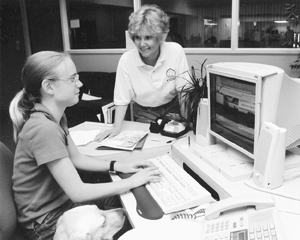
This book and the complementary video series, Taking Charge: Stories of Success and Self-Determination, explore positive internal characteristics and external factors that contribute to success—personally, socially, spiritually, academically, and professionally. These factors can be used to provoke thought and promote interaction between teens and caring adults.
The book also tells how you can set up a mentoring community on the Internet where young people and their mentors share ideas that contribute to a successful transition to adult life. A complementary video for this book, Opening Doors: Mentoring on the Internet, shares reports from teens and mentors who have participated in a successful e-mentoring community sponsored by DO-IT (Disabilities, Opportunities, Internetworking and Technology). Another video, How DO-IT Does It, shares details about the DO-IT Scholars program, within which this mentoring community is one strategy to help teens with disabilities achieve success in postsecondary education and careers.
Another complementary video, DO-IT Pals: An Internet Community, tells teens how to gain maximum benefit from and have fun in an electronic mentoring community. It also invites teens with disabilities to join the DO-IT Pals online community.
If you wish to set up your own electronic mentoring community, follow the instructions provided in Part I of this book and then choose online activities from Part II that are most appropriate for your participants. The discussion exercises described are targeted to college-bound teens with disabilities—high school students for whom a technical college, community college, or four-year institution is part of their future plans. However, activities can be easily modified for teens without disabilities, individuals at other age levels, and young people with different goals. For students whose reading level is low, speech output software can be used to read the messages aloud, or the student can work with an assistant side by side. The content of this book can also be used to stimulate in-person conversations and activities within your home, community group, summer camp, or classroom.
In this book you will not find the stories of movie stars, international leaders, or other celebrities. Although the content is based on personal experiences of successful people with disabilities, all of the people represented here would not be considered superachievers in all areas of their lives. You'll hear the stories of everyday people striving for the best life has to offer. This book highlights advice from people who confront barriers as challenges rather than deterrents, who find insight and humor during trying times. It shares some of the attitudes, skills, and strategies that have contributed to the success of people with a wide range of disabilities, abilities, experiences, and personalities. The experts who provide the major content for this book share their dreams, goals, challenges, successes, and frustrations. They tell about their experiences and give advice about how to successfully transition from high school to college, careers, and independent living. Perhaps their stories will provide inspiration as you help those around you define and achieve success for themselves.
In short, this publication is:
- a how-to book for setting up an electronic mentoring community
- an invitation to recruit teens with disabilities to the DO-IT Pals online program
- a collection of activities to help teens with disabilities develop self-determination skills and transition to college, careers, and independent living
- a place where you will gain insights from successful individuals who have met and continue to meet life's challenges, including those imposed by disabilities
The following video presentations complement the content of this book:
- Taking Charge 1: Three Stories of Success and Self-Determination
- Taking Charge 2: Two Stories of Success and Self-Determination
- Taking Charge 3: Five Stories of Success and Self-Determination
- Opening Doors: Mentoring on the Internet
- How DO-IT Does It
- DO-IT Pals: An Internet Community
These presentations can be freely viewed online on the DO-IT Video page or purchased from DO-IT in DVD format.
History and Current Trends Regarding People with Disabilities
For much of the content of this book, experts—people with disabilities who have been successful in academic studies and/or careers—were consulted. There are few publications like this in which the voices of people with disabilities are heard. Why is this the case? At least a partial answer lies in the history of isolation, exclusion, and dependence of people with disabilities (Fleischer & Zames, 2001).
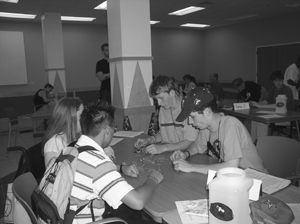
Exclusion and Dependence
In early times, children born with disabilities were hidden and sometimes even killed. Feelings of shame and guilt were often associated with giving birth to a child with a disability. Sometimes the disability was blamed on sins of family members. Even as people with disabilities became more accepted, society viewed disability as a personal tragedy with which the individual and family must cope. Feelings of pity and actions of charity were typically evoked in others. Even successful individuals such as Franklin D. Roosevelt tried to hide their disabilities. Early on, organizations focused on the prevention and cure of disabilities. Successful funding campaigns, even to this day, often share images of helpless children with disabilities apparently doomed to a miserable life. In the 40s and 50s parents organized and advocated for education and services for their children with disabilities, but the children were not routinely encouraged to advocate for themselves. Children with disabilities rarely encountered successful adults with disabilities.
Civil Rights and Accommodations
The impact of the return of disabled veterans after World War II and the fights for civil rights of women and racial and ethnic minorities contributed to changing perspectives on disability in the United States. Growing numbers of people with disabilities and their advocates saw that it was not disability but rather an inaccessible environment and the negative attitudes of others that were the greatest contributors to the restrictions they encountered. Their view that access to programs and services was a civil right led to legislation that included the Architectural Barriers Act of 1968, the Rehabilitation Act of 1973, the Education of All Handicapped Children Act of 1975 (later updated and renamed the Individuals with Disabilities Education Act, IDEA), and the Americans with Disabilities Act of 1990 (ADA). These and other laws mandate that people with disabilities have full access to education, transportation, technology, employment, and other life experiences. Sometimes this requires that reasonable accommodations be made.
Universal Design and Diversity
Although buildings are now built with accessibility features as part of the original design, only recently has the concept of universal design been promoted in the development of technology, learning environments, services, work sites, and information resources (Burgstahler, 2001b). When universal design principles are applied, environments, programs, and resources are accessible to people with a broad range of abilities, disabilities, and other characteristics, minimizing the need for special accommodations. Widespread applications of universal design can ultimately lead to a world that is more accessible to everyone. They support the full inclusion of people with disabilities and other underrepresented groups in recognition that diversity is a necessary condition for excellence in education, employment, and social settings.
Self-Determination and Independence
The content of this book is supported by decades of research and scholarship that tell us about how individuals with different types of disabilities lead challenging and rewarding lives. Simply put, this book is about self-determination. But what is self-determination? There are many definitions from which to choose. The following definition (Field, Martin, Miller, Ward, & Wehmeyer, 1998, 1999) provides a foundation for the content of activities in this book.
Self-determination is a combination of skills, knowledge, and beliefs that enable a person to engage in goal-directed, self-regulated, autonomous behavior. An understanding of one's strengths and limitations together with a belief in oneself as capable and effective are essential to self-determination. When acting on the basis of these skills and attitudes, individuals have greater ability to take control of their lives and assume the role of successful adults. (Field et al., 1998, p. 2)
The Council for Exceptional Children (CEC), along with many other professional organizations and parent groups, embraces instruction in self-determination as a way to improve academic and career outcomes for youth with disabilities. Self-determination is also promoted in legislative mandates. For example, the Individuals with Disabilities Education Act requires that students with disabilities actively participate in their transition planning and that their preferences and interests be considered. It affirms the right of people with disabilities to self-determination.
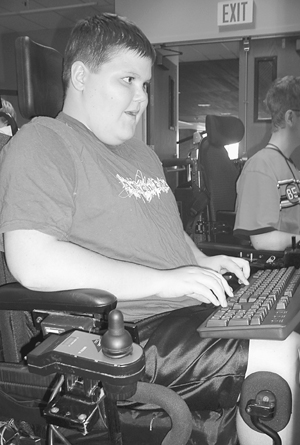
Gaining control over one's life involves learning and applying self-determination skills. These include self-awareness, goal-setting, problem-solving, and self-advocacy. The personal process of learning, applying, and evaluating these skills in a variety of settings is at the heart of self-determined behavior that leads to successful transitions to adulthood. The activities in this book provide opportunities for young people to reflect on their own experiences as well as learn and practice self-determination skills. They share the lessons learned by those who are successfully traveling the road to self-determined lives and provide a model of how young people can be guided toward self-determined behavior within an online mentoring community. Although not a comprehensive course on self-determination, the activities in this book are consistent with the performance-based standards for the preparation of special educators adopted by the National Council for Accreditation of Teacher Education (2002) for program accreditation. Examples of characteristics of special education teachers that directly address components of self-determined behavior noted in this report include:
- "enhance the learning of critical thinking, problem solving,...." (p. 2)
- "increase their self-awareness, self-management, self-control, self-reliance, and self-esteem." (p. 2)
- "emphasize the development, maintenance, and generalization of knowledge and skills across environments, settings, and the lifespan." (p. 3)
- "foster....positive social interactions, and active engagement,...." (p.3)
- "encourage the independence, self-motivation, self-direction, personal empowerment, and self-advocacy...."(p.3)
- "develop a variety of individualized transition plans, such as transition from preschool to elementary school and from secondary settings to a variety of postsecondary and learning contexts." (p. 4)
- "use collaboration to facilitate the successful transitions...." (p. 6)
Growing evidence suggests that enhanced self-determination skills enable students with disabilities to perform more effectively in academic studies and thus support the goals of No Child Left Behind legislation and standards-based school reform. In addition, many state standards for students include elements of self-determined behavior such as goal setting, problem solving, and decision making. There exists a wide variety of self-determination curricula; some can be located by consulting the resources and bibliography in Chapter Fourteen of this book. The activities in this book were developed after a comprehensive literature review, with special attention given to the self-determination curriculum that has been field-tested (Test, Karvonen, Wood, Browder, & Algozzine, 2000).
Developing self-determination skills within an online mentoring community has limitations. It is recommended that the activities in this book be augmented with opportunities to apply what is learned. Teachers, parents, and other caring adults can help young people by providing opportunities for choice, problem solving, and decision making. For very young children, letting them choose between several books to read, games to play, or clothes to wear may be appropriate; as they grow older, opportunities for greater control should be provided. The key is steady growth in the number and complexity of choices they can make that affect their lives.
DO-IT
In 1992, with a grant from the National Science Foundation, I founded DO-IT at the University of Washington. DO-IT has grown from that seed into a collection of projects and programs that help young people with disabilities successfully pursue college and careers, using technology as an empowering tool. The disabilities of participants in DO-IT programs include sensory impairments, mobility impairments, attention deficits, and learning disabilities. DO-IT also helps educators, technology staff, librarians, and employers create academic offerings, information resources, and employment opportunities that are accessible to people with disabilities. (Burgstahler, 2006a, 2003a; Kim-Rupnow & Burgstahler, 2004).
My motivation to create DO-IT drew from both personal and professional experiences. My relationship with a family friend who was developmentally disabled taught me at a young age that no single set of criteria should be used to measure success. From my years as a middle and high school teacher I gained insight into the challenges teens face as they move toward adult life and the corresponding challenges caring adults face as they try to help them on this journey. Personal experiences with young people and adults with disabilities taught me that the low expectations and negative attitudes of others create the greatest barriers to success for people with disabilities and that facing the challenge of a disability is too often an isolating experience. My close relationship with a child who is quadriplegic revealed the doors that can be opened with assistive technology, telecommunications, and alternative strategies for reaching goals. My roles as an aunt and as a mother created my greatest interest in exploring how we can help children define success for themselves and develop the beliefs, attitudes, and skills they need to set and reach these goals.
DO-IT is a collection of projects and programs to increase the number of people with disabilities who:
- use technology as an empowering tool
- communicate with peers and mentors in a supportive electronic community
- develop self-determination skills
- succeed in postsecondary education and employment
- pursue careers that were once considered unavailable to them, such as science and engineering
- have opportunities to participate and contribute in all aspects of life
Life Stages of DO-IT Participants
| Level | Participants |
| High School | DO-IT Scholars DO-IT Pals |
| College | DO-IT Ambassadors DO-IT Mentors |
| Careers | DO-IT Ambassadors DO-IT Mentors |
Most of the stories and advice presented in this book belong to DO-IT Scholars, Pals, Ambassadors, and Mentors. DO-IT Scholars are college-bound high school students with disabilities who are self-motivated, are successful in school, and show leadership potential. Their disabilities include mobility impairments, visual impairments, hearing impairments, learning disabilities, attention deficit disorders, speech impairments, and health impairments. Scholars attend at least two residential Summer Study programs at the University of Washington in Seattle. They are introduced to college life, resources, and academic studies and develop self-determination skills. They participate in internships and other work-based learning experiences that prepare them for career success.
With computers and assistive technology, they use the Internet to access information and communicate with others in a stimulating electronic community. High school graduates who continue to participate as DO-IT Scholar alumni become DO-IT Ambassadors. As Ambassadors, they mentor younger Scholars and contribute to DO-IT efforts in many ways. The community also includes DO-IT Mentors—other college students, faculty, and professionals in a wide variety of fields, many of whom have disabilities themselves. DO-IT Pals, college-bound teens with disabilities from around the world who wish to participate in our online mentoring community, have joined the DO-IT family as well. The success of this approach where young people and adults share their views in a mentoring community motivated me to include the perspectives of a large group of people with disabilities in this book.
During the more than a dozen years I have initiated and directed DO-IT's successful electronic community, I have often been asked by other program directors how to design and support their participants through similar online interactions. It is easy to describe the basic scheme. But attention to myriad details and ongoing operations makes the system work. This book shares both the process and examples of the content of DO-IT's electronic community in a way that lessons learned can be applied in other circumstances and with different audiences. The fact that our participants have disabilities, for example, is just one characteristic of our target audience. The basic concepts and activities can be tailored to any group of teens, or, with some modifications, they can be used with younger students, with adults, or with students from other groups facing special challenges due to racial/ethnic background, gender, or socioeconomic status.
The Role of Technology in Creating this Book
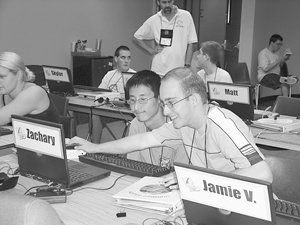
Most of the personal stories, online activities for teens, and tips for mentors included in this book were collected over the Internet. To complete this work, I sent questions via electronic mail to DO-IT Scholars, Pals, Ambassadors, and Mentors and to some participants with disabilities in other programs funded by the Mitsubishi Electric America Foundation. Contributions were returned in email messages. Those who are blind used speech and Braille output systems to read my requests. Those with mobility impairments used specialized software and alternative keyboards to enter their contributions. For those who have difficulty communicating face to face because of speech or hearing impairments, their disabilities did not impact their participation in these Internet-based communications.
Responses to requests for input were numerous and lengthy. I edited the original messages to fit the material into a book of reasonable length. I attempted to capture the essence of each contribution.
What You'll Find in this Book
The chapters in this book take you on a journey of discovery, looking at success and self-determination from a variety of perspectives and learning how students with disabilities can be supported within an online mentoring community. The book is divided into three main sections.
PART I addresses the philosophy and purpose of online mentoring. It tells how to establish the community, recruit and train mentors and protégés, provide guidelines for participants, and initiate online discussions. Complementary videos reinforce this content.
PART II is organized around seven recommendations that were synthesized from hundreds of responses from the young people and adults with disabilities who contributed to the content (Burgstahler, 2006c):
- Define success for yourself.
- Set personal, academic, and career goals. Keep your expectations high.
- Understand your abilities and disabilities. Play to your strengths.
- Develop strategies to reach your goals.
- Use technology as an empowering tool.
- Work hard. Persevere. Be flexible.
- Develop a support network. Look to family, friends, and teachers.
Each chapter contains the text of messages to support an online community. Each can be sent by a program administrator to mentors alone or to mentors and protégés together.
PART III presents protégés and mentors with a forum to share their own stories and experiences and suggests additional resources for participants and administrators.
How to Use this Book
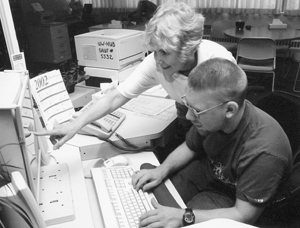
This book is designed for use by a parent, guardian, teacher, or program administrator searching for strategies to help young people with disabilities gain the skills they need to lead successful, self-determined lives. Specific guidelines are included for setting up and supporting a mentoring community on the Internet. If you do not have access to the Internet at home or school, explore Internet access options at your local library. Once the technical aspects of the community are dealt with and the participants identified, the electronic community administrator should choose mentoring tips and online activities that are appropriate for the people with whom they work. Although the online activities are presented in a logical order, they can be used in any order appropriate for the target audience.
Completing the activities presented in this book will help precollege students with disabilities identify their strengths and challenges and develop skills for success in all areas of their lives. If you are not in a position to create and support an electronic community, consider using the activities in a classroom, computer lab, summer program, or other setting, with or without computers. Activities can be completed independently but are more stimulating when a young person works with a fellow student, mentor, or other adult. In a group with their peers, even reluctant learners choose to participate. Sharing responses and ideas in a small group stimulates a rich discussion once participants realize there are no right answers and everyone's opinion has value.
How to Download or Purchase this Book and Complementary Videos
It might be helpful for you to have electronic copies of the exercises for modification and application in your setting. The most current electronic copy of these materials can be found at Creating an E-Mentoring Community: How DO-IT does it, and how you can do it too. Videos that complement the content of this book can also be found there for free online viewing; trainers can freely download copies of videos to project from their own computers by directing requests to doit@u.washington.edu. Other DO-IT videos can be viewed on the DO-IT Video page.
Copies of the printed book and videos can also be purchased from DO-IT. Details can be found on the DO-IT Free Publications Order Form. Free DO-IT publications can be found on the Resources page.
Sheryl Burgstahler, Ph.D.
Founder and Director, DO-IT
College of Engineering and Computer Science
Computing & Communications
College of Education
University of Washington